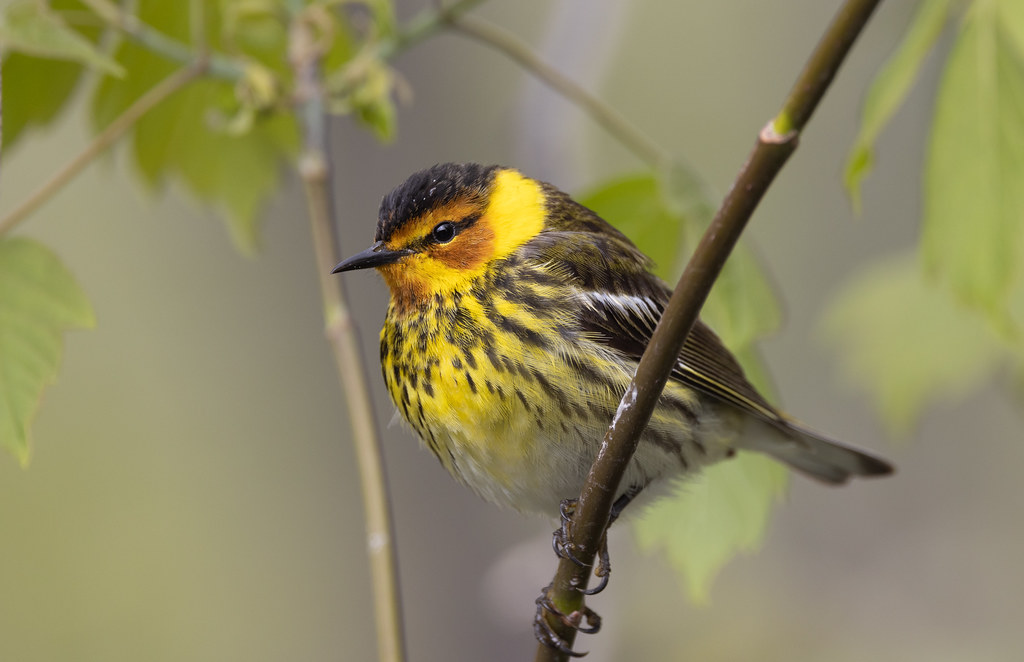Cape May Warbler
| Setophaga tigrina | Order: Passeriformes | Family: Parulidae (New World Warblers) |
This handsome warbler has a more curled tongue with a brushier tip than most warblers, allowing it to feed on Yellow-bellied Sapsucker sap wells and some sources of nectar. (You can learn more about this at my blogpost, More about Bird Tongues than a Normal Person Would Want to Know)
This is the warbler most often attracted to oranges and jelly feeders during migration. One frigid spring, I had one visiting a hummingbird feeder without perches—the little guy actually hovered at the feeder for a second or two slurping sugar water, then alighted on a nearby branch to rest a bit, and repeated.
Cape May Warblers winter in the West Indies, feeding on nectar, fruit, and insects. They breed in northern coniferous forests, where they feed mostly on insects, especially spruce budworm. They’ve declined a full 72 percent since 1966, thanks especially to pesticide formulations targeting their primary food source. Because they’re easy to see during migration while feeding on nectar, birders often don’t appreciate how much their numbers have dropped over the past 50 years.
To hear the high-frequency songs and calls of this or any other species with high-pitched vocalizations, even with my hearing aids, and to get a direction for them, I use Lang Elliott’s “Hear Birds Again”. The app is free to download, and the website has clear and easy directions to make the fairly inexpensive binaural headphones. To know if the bird is there in the first place, I use the Cornell Lab of Ornithology’s Merlin app.
Laura's Published Works
Radio Programs
- Cuban Woodpeckers 2025
- Jelly Redux 2024
- The Sapsucker–Hummingbird Connection 2024
- Warblers! 2024
- Summer Update 2023
- Jelly is killing hummingbirds! 2023
- Birds Specializing on Conifers 2023
- Bird Recordings and the Merlin App 2022
- Sweetness in Hard Times 2022
- Tennessee Warblers 2022
- My Most Colorful Spring and an Adorable Little Despot 2022
- Feeding Jelly 2019
- Spring Update 2019
- Distressing News for Birders with Hearing Loss 2019
- Yellow-rumped Warblers 2018
- Fiftieth Anniversary! 2018
- Yellow-bellied Sapsucker 2016
- August Birding 2011
- Winter Bird Movements 2010
- Photography, Part II 2010
- Photography, Part I 2010
- Ice Storms 2007
- Bird Photography 2005
- Cape May Warbler 2004
- Cold Spring! 2004
- Jelly Belly 2004
- Mealworms 2003
- A Walk in Port Wing 2003
- Warbler Days 2003
- Spring Migratory Flocks 2003
- Big Migration Day 2002
- E-mail questions 2001
- Warblers and Edge 2000
- My Favorite Warbler 2000
- Yellow-bellied Sapsucker 2000
- Wintering Cape May Warbler 2000
- Silly Bird Names 1998
- Cape May Warbler 1995
- Essential Nature of Mature and Dying Trees 1991
- Northern Oriole 1990
- National Warbler Awareness Week: My Favorite Warbler 1989
- National Warbler Awareness Week: Blackburnian Warbler 1989
- Baltimore Oriole 1989
- Attracting Birds in Late Spring 1989
- Watching migration 1989
- Attracting Birds in Spring 1989
- Orioles 1987
- Silly Bird Names 1986
- Attracting Birds in Late Spring 1986
- Lousy Weather: Spring Update 1986
